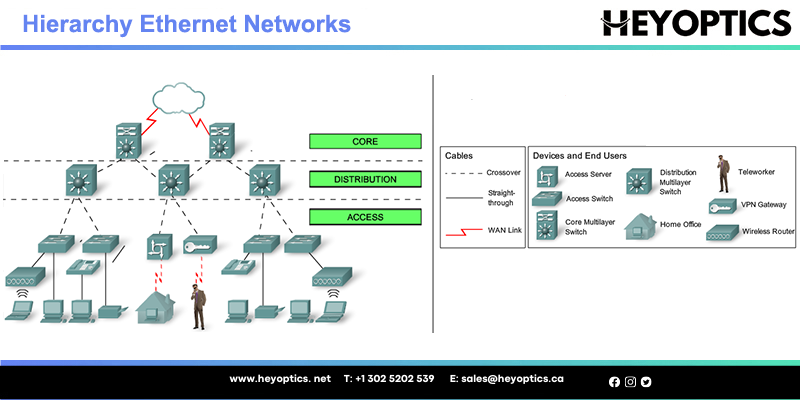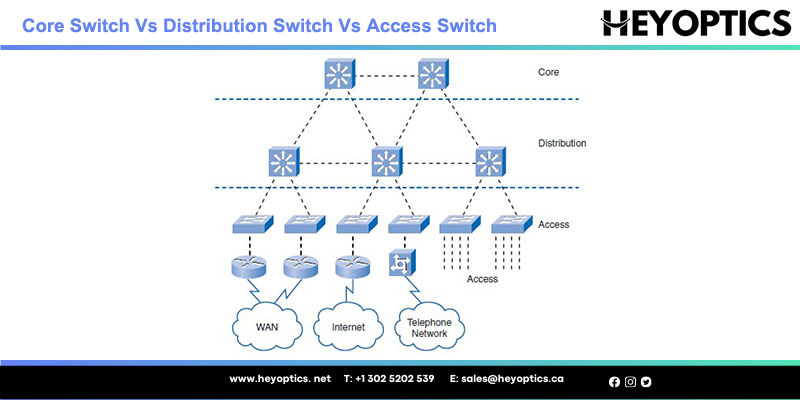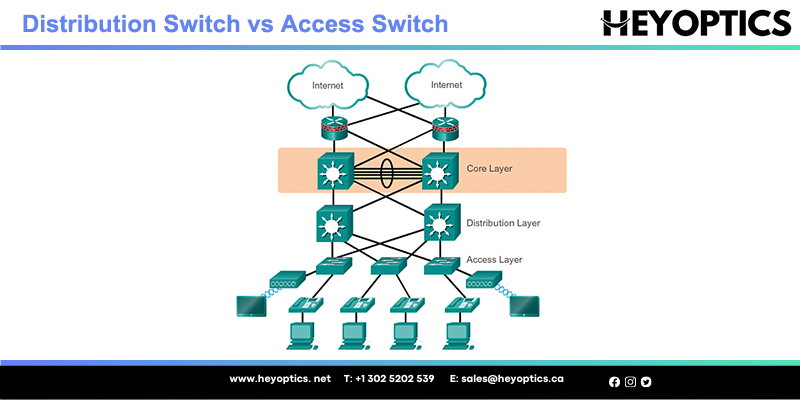Core Switch Vs Distribution Switch Vs Access Switch:What’s the difference?
Ethernet networks are expanding and their designs are evolving and getting complex. The high capacity wide area networks (WAN) networks are introduced in telecommunication, business communication, industrial automation, and many other types of networking applications. However, owing to the intricacy of such networks, periodic maintenance, troubleshooting, and upgrades are performed in different phases. The networks are built in layers to ease maintenance-related issues. Multiple layers consist of different devices integrated.
The layers of networks may consist of devices like transmitters, receivers, media converters, network switches, etc. Out of all the devices, the network switches play important role in managed Ethernet networks. The switches contribute to directing the data and are responsible for the transmission of signals to the addressed devices only.
Different types of Ethernet switches perform different roles in the layers of high-capacity networks. Core switches, distribution switches, and access switches are the common types of switches used in layer-based or hierarchy Ethernet networks. This post mainly explores the confusing problem: core switch vs distribution switch vs access switch.
An Overview of Hierarchy Ethernet Networks
The hierarchy Ethernet network is a three-layer integrated setup of networking devices. These networks are designed with three tiers that facilitate strategic installation, management, maintenance, and so on. The strategic design of a hierarchy network may comprise more than three layers, however, the base foundation of this network consists of three layers i.e.; the core layer, distribution layer, and access layer.

What Is Core Switch?
A core switch is not a certain kind of network switch. It refers to the data switch that is positioned at the backbone or physical core of a network. Therefore, it must be a high-capacity switch to serve as the gateway to a wide area network (WAN) or the Internet. In a word, it provides the final aggregation point for the network and allows various aggregation modules to work together.
Important Parameters of Core Switches
Owing to the importance of core switches, the quality and performance of the core network switches must be tested. To ensure that the switches can perform tasks of the core layer or collapsed core layer, the following parameters should be checked.
- Forwarding Rate: The forwarding rate is an essential parameter of core switches. As the core switches are responsible for routing and switching a high amount of data, the forwarding capacity of the switches must be high. The forwarding capacity of switches is known as the forwarding rate. This indicates the number of data packets transmitted at any time. The core switches with a high forwarding rate are suitable for core layers. However, if the low forwarding rate is there, then multiple switches are used in a collapsed core layer.
- Quality of Service (QoS): Quality of Service (QoS) is essential in core switches. This parameter allows the strategic release of data packets. Since the networks are highly demanding and a massive amount of data passes through the core layer, the QoS enables the selective transmission of data packets. This way the forwarding of data packets is prioritized and therefore, important data transmits first and the least important data is sent last.
- Redundancy: This factor of core switches should be considered so that abrupt failure can be prevented. Using swappable cooling fans and power supply modules with switches can help in enhancing redundancy.
- Compliance with Ethernet Protocols: Since the Ethernet networks are built over IEEE standards. The switches and other devices operate based on the version of IEEE standards. Therefore, the core switches should operate in compliance with Ethernet protocols being used for building the network.
- Compatibility with Different Networking Topologies: In intricate networks, a single core switch may not suffice. To install multiple cores switches, the core layer must be collapsed. Thus, the topology of networking may differ. The core switch should perform incompatibility with the adopted topology.
What Is Distribution Switch?
Similarly, the distribution switch lies in the distribution layer, and it links upwards to the layer core switch and downwards to the access switch. It is also called an aggregation switch which functions as a bridge between the core layer switch and the access layer switch. In addition, the distribution switch ensures that the packets are appropriately routed between subnets and VLANs in the enterprise network. 10GB switch usually can perform as a distribution switch.
Important Parameters of Distribution Switches
The following parameters are essential for a distribution switch to perform effectively in layer 2.
- Layer 3 Functional Compatibility: Although the distribution switches are layer 2 switches, the compatibility of these switches with layer 3 switches is important. As the layer 2 switches directly interact with layer 3 switches, the transmission compatibility of both layers should match.
- Link Aggregation: Chances of link failure are high between the access layer and distribution layer. Therefore, the distribution switches must offer link aggregation for quick recovery. This feature balances the distribution of traffic which results in the prevention of link failure. In case of link failure, the diversion of transmission path and recovery of a failed link is done by link aggregation capabilities of the layer 2 switches.
- Security Policies: The high-capacity networks are sensitive to data theft and party intrusions, therefore, the security measures are implemented at the second layer. As this layer bridges the core and access layer, security measures like access control list (ACL), user access authentication, etc are introduced in layer 2 switches. The switches should be compatible with security modifications.
- QoS/ Data Prioritization: Since layer 2 switches strategically forward the data, the Quality of Service (QoS) capability of these switches offers prioritization of data packets. This way although the data is forwarded to different layer 3 switches, it can be sent at different time lapses based on priority.
What Is Access Switch?
The access switch is generally located at the access layer for connecting the majority of devices to the network, therefore it usually has high-density ports. It is the most commonly-used gigabit Ethernet switch that communicates directly with the public Internet, mostly used in offices, small server rooms, and media production centers. Both managed and unmanaged switches can be deployed as access layer switch.
Important Parameters of Access Switches
Since the access layer is the most interactive layer of the hierarchy network, the following parameters of access switches must be confirmed.
- Port Density: The port density is the number of ports on the access switches. Since access switches are directly linked to subnets and end-users networking devices, having a higher port density is an advantage. The higher the port density of each access switch is, the lower the number of access switches used in the access layer.
- Port Speed: The access switches commonly come with 10/100/1000Mbps data transmission speed. Different networking activities require different transmission speeds. With an increase in demand for high-speed gigabit transmission, the ports of access switches should support the high-speed transmission of data to the subnet devices.
- Convenient Installation and Management: As multiple access switches are integrated into the access layer and additional switches may be required. To do the same easy installation is essential for the access switches. It makes the network easy to install and manage the networking parameters.
- Security: Chances of third-party intrusion through the access layer are high since it can be accessed easily. Therefore security protocols of these switches must be checked. Access control, IP source protection, DoS protection, etc should be implemented to access switches.
- Device Compatibility: The compatibility of layer 3 switches with end users’ devices is important for efficient data transfer.
Considering all the above-mentioned factors, core switches, distribution switches, and access switches can be chosen. However, to ensure the efficiency of the network, the quality of switches and performance parameters should be verified.

Comparison: Core Switch Vs Distribution Switch Vs Access Switch
The switches may co-exist in the same network, and coordinate with each other to contribute to an unrestricted network speed with each layer switch performing its duty. Well, what’s the difference: core switch vs distribution switch vs access switch?
Core Switch Vs Access Switch
The lower levels the switch dwells in, the more devices it connects to. Therefore, a big gap in ports number exists in the access switch and core switch. Most access switches need to connect various end-user equipment ranging from IP phones to PCs, cameras, etc, While the core switch may be just linked with several distribution switches. Meanwhile, the higher layer the switch lies in, the faster port speed it requires. Access switch is to core switch what river is to the ocean, as the latter one has the large throughput to receive the data packets from the former one. Most modern access switches come with 10/100/1000Mbps copper ports. An example of this is FS S2800–24T4F 24 port 100/1000BASE-T copper gigabit Ethernet switch. While core switches commonly have 10Gbps and 100Gbps fiber optic ports.
Distribution Switch Vs Access Switch
As the access switch is the one that allows your devices to connect to the network, it undoubtedly supports port security, VLANs, Fast Ethernet/Gigabit Ethernet, etc. The distribution switch which is mainly responsible for routing and policy-based network connectivity supports additional higher performance like packet filtering, QoS, and application gateways. All in all, the access switch is usually a layer 2 switch, and the distribution switch is a Layer 3 switch. When multiple access switches among different VLANs are required to be aggregated, a distribution switch can achieve inter-VLAN communication.

Core Switch Vs Distribution Switch
The core switch has higher reliability, functionality, and throughput than the distribution switch. The former aims at routing and forwarding, and provides an optimized and reliable backbone transmission structure, while the latter functions as the unified exit for access nodes, and may also do routing and forwarding. The distribution switch must have a large enough capacity to process all traffic from the access devices. What’s more, there’s generally only one (or two for redundancy) core switch used in a small and midsize network, but multiple distribution switches in the distribution or aggregation layer.
Conclusion
How to choose: core switch vs distribution switch vs access switch. To sum up, the access switch facilitates devices to the network. The distribution switch accepts traffic from all the access layer switches and supports more high-end features. And the core switch is responsible for routing and forwarding at the highest level.
Complex Ethernet networks feature a hierarchy comprising multiple layers. The core layer, distribution layer (layer 2), and access layer (layer 3) are the three layers used to build hierarchy networks for industrial, domestic, and commercial data transmission. All three layers of the hierarchy network are introduced in this white paper along with the sole responsibility of each layer. Further different types of network switches used in these networks are discussed, namely, core switches, distribution switches (layer 2 switches), and access switches (layer 3 switches). Since the selection of appropriate switches is essential to building a high redundancy network, therefore important parameters of these switches are discussed individually.



